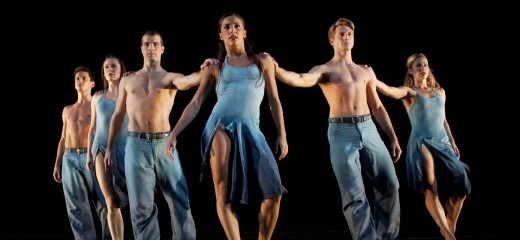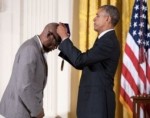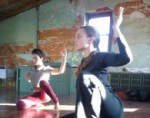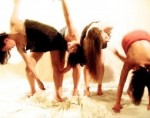
Photo: Krista Bonura
Talking Parsons: Devices and Digressions
by Lisa Bardarson
Lisa Bardarson: I like the process of viewing works of dance collaboratively. So I was excited to be co-reviewing Parsons Dance with my thINKingDANCE colleague, Kirsten Kaschock, not only because I respect her insights and writing but, because her brother Alex performed with the company from 1992–1995, Kirsten has background in Parsons that many don’t. As for myself, I’ve always been an admirer of the athleticism that Parsons’ work demands and appreciative of the incredible dancers in his company. Knowing we would be viewing
Caught, each for the umpteenth time, I wondered if viewing it together might give us some fresh insight into Parsons’ signature work. Our post-performance conversation began in the lobby then continued on to a local bar where we proceeded to dissect the evening with gusto. We volleyed even more insights via email. What follows is a melding of our conversational process.
Kirsten Kaschock: What do you think of Parsons’ tendency to develop a relatively simple concept into a 10-15 minute work?
LB: Let’s talk about concept vs. device because I experienced both in this performance. You know how a device can be a help or a hindrance in choreography? What I’m trying to say is that a piece that relies too heavily on a single idea without developing choreography is, to me, an artistic copout. At a certain point, it moves to gimmickry and I start feeling cheated. Instead of the device being a means to an end, it becomes an end in itself and, boo hoo…I’ve been robbed.
KK: I know what you mean, but when a movement theme is pressed through a hundred permutations, it can be strangely satisfying—as if the choreographer is demanding a type of creative stamina from him/herself not unlike the boundless athleticism Parsons asks of his dancers. In the evening’s first two pieces, Round My World and Hand Dance, I kept trying to anticipate the next bit of circularity and wondering just what more was possible with only hands visible onstage.
LB: I completely agree! And I thought Round My World was a clear example of how a device could be used with a favorable result. I was impressed with how artfully this piece for three men and three women carried the theme of roundness through the dance. Some examples—the ensemble moving in a circle, creating circles with arced arms, and tracing the shape through space via turning lifts and spatial floor patterns. The wheels of this concept turned seamlessly throughout the piece leaving no question that this dance was going to explore circularity to thorough satisfaction. I felt sated, as though I’d just had a big bowl of Cheerios with half-and-half and a teaspoon of sugar. Yum.
KK: What did you think of the second piece?
LB: You’re talking about Hand Dance, and I wasn’t crazy about it. In this piece the dancers are lit so that all we see are ten pairs of hands in a straight line. The hands themselves become the dancers and perform a multitude of entertaining tricks like a can-can, a kinetic wave, fanning hands unfurling like a flower and a wild piano performance to name a few. The dance is clever but doesn’t lead me to a place of transcendence—something which I crave in live performance. But who am I to quibble? The audience LOVED it.
KK: They did, didn’t they? I have never been to a Parsons performance that didn’t thrill the audience. Even in Hand Dance, which wasn’t my favorite either, the exuberance was contagious (and the piano arrangement by Kenji Bunch kept upping the ante). This is something that I remember from the first time I saw the company—the performers seemed so joyful. I think it’s hard not to be affected by that energy, even if the movement vocabulary or the structures don’t excite you the same way.
LB: This is so true—Parsons really knows how to wow an audience as evidenced in Hand Dance and Caught. Both of these pieces are crowd pleasers in part because they provide easy access to the viewer.
KK: In the 1990s his company often ended a show with a piece called
Nascimento—also loved by audiences, but with bigger dynamic changes between the sections and a developing relationship between two central dancers. So Parsons has made work with more emotional content and a bit of a narrative trajectory. I missed those elements in the show we saw except in
A Stray’s Lullaby—the only piece on the program not choreographed by Parsons, but by former company member, Katarzyna Skarpetowska. I think, though, if we’re talking about audience enthusiasm, we need to address
Caught—that tour-de-force of gravity-defiance and technology. I can’t believe it premiered in 1982.
LB: Simply put, this dance for solo male dancer relies on a timed strobe so that he appears to hover magically in the air for several minutes. My annoyance at having to see this piece for the millionth time probably comes from my wishing I’d come up with the idea myself. A dance that consistently wins performance engagements for Parsons for thirty years is the dance equivalent of a blockbuster – it’s enough to make any choreographer fiendishly jealous. I don’t feel good about this!
KK: It’s not just you--dancers can be envious too. I have it on good authority that performing this piece makes a dancer feel like a god. (Though the devil’s in the quadriceps.) But I need to correct you—this dance has been performed a handful of times by women. My sister, Taryn Kaschock Russell was one, and she recently talked about the experience in
this interview. But what I love about this piece, why it still amazes, is that it is completely unapologetic about its reliance on technology, virtuosity, and pure brute will. The dancer is pushed to his or her physical limits as a gift to the spectator. I’m actually glad that audiences continue to appreciate that generosity.
LB: What did you think of the make-up of the company?
KK: It seemed more homogeneous than I remember. The last time I saw them perform, the current director of Alvin Ailey,
Robert Battle, was in the troupe—and his presence was both sensual and substantial. Don’t get me wrong, all the dancers we saw were phenomenal athletes and giving performers, but the company seemed more uniform in race, body-type, and in its one-note presentation of heterosexual attraction onstage than I remember it from a decade (or two) ago.
LB: I completely agree, Parsons seems to be choosing dancers these days of similar height and build although the exception to this was dancer Jason MacDonald, whose bigger stature and scruffy beard made him a stand-out. Initially, my eyes were drawn to him for these distinguishing features, but I soon recognized that it was his charismatic physicality and grounded strength that had me riveted. I wonder if MacDonald’s powerful yet nuanced dancing trumped Parsons predilection for uniformity?
KK: MacDonald drew my eye as well, especially during his solo in
A Stray’s Lullaby where I thought, in contrast to the other male dancer’s clean-cut looks, his appearance better matched the Tom Waits-ish score. It made me think about diversity in look and body-type as a compelling and motivating factor in the choreography—as it historically has been for choreographers like
Bill T. Jones.
LB: Body type is an interesting topic. Many a famous choreographer has been pre-disposed towards a certain look. For instance, I know that Balanchine preferred dancers who were long of limb and tiny of head. Just look at Suzanne Farrell if you don’t believe me. Parsons seems to be choosing dancers that look similar, and I wonder if this is to give his choreography a tidier look. His dances are fastidiously rehearsed, and I do think the homogeneity of dancers contributes to a more streamlined feel. With your inside connections Kirsten, it would be great to ask him. Do you have his number?
KK: Not on me. Sorry, Lisa. As to the company being well-rehearsed and clean of line—Parsons’ heritage is, after all,
Paul Taylor. But in Parsons’ genetic make-up, I think Taylor’s dark trickster-ish traits must have been recessive. During the performance, I yearned for some Taylor-esque edginess. Nevertheless, it’s a happy thing to hear the sounds of an audience so floored by movement. I just want it all I guess: commitment, cohesion, and conceptual work that engages me on a deeper level than in its formal play. Is that so wrong? Damn, I hope not.
Dance Celebration presented by Dance Affiliates and the Annenberg Center, Parsons Dance Company, Wednesday, February 27, 2013.
By Lisa Bardarson
March 9, 2013











